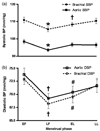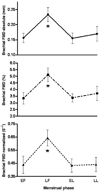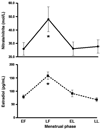Central, peripheral and resistance arterial reactivity: fluctuates during the phases of the menstrual cycle
- PMID: 20404025
- PMCID: PMC2967291
- DOI: 10.1258/ebm.2009.009186
Central, peripheral and resistance arterial reactivity: fluctuates during the phases of the menstrual cycle
Abstract
The purpose of this study was to document the temporal changes in vascular reactivity occurring simultaneously in central, peripheral and microvascular resistance arteries in the same cohort of women during the normal menstrual cycle. Twenty-three (n = 23) women (mean age (+/-SD) = 19 +/- 1 y) were tested during four phases of a normal menstrual cycle. Delineation of the four phases occurred as follows: (1) the early follicular phase; (2) the late follicular (LF) phase; (3) the early luteal (EL) phase; and (4) the late luteal phase. Non-invasive measurement of central hemodynamics and peripheral artery pulse wave velocity (PWV) were performed using applanation tonometry. Measurement of peripheral endothelial function was determined by flow-mediated dilation (FMD) testing in the brachial artery and venous occlusion plethysmography in the forearm and calf resistance arteries. Additionally, plasma NOx and 17beta-estradiol (E) concentrations were measured. Both central (aortic) and peripheral blood pressure (BP) were lowest (P < 0.05) during the LF phase and BP reduction was sustained (P < 0.05) into the EL phase. The timing and amplitude of the reflected pressure wave were attenuated only during the LF phase (P < 0.05). No temporal changes were observed in either central (carotid-femoral) or peripheral PWV (femoral-dorsalis pedis, carotid-radial). Peak forearm and calf blood flow during reactive hyperemia were greatest in LF. Brachial FMD was greatest during the LF phase (P < 0.05). Plasma E and NOx concentrations were highest during the LF phase (P < 0.05). Young premenopausal women experienced an overwhelming pattern of reduced BP and increased systemic vascular reactivity during the LF phase prior to ovulation.
Figures




References
-
- Williams MR, Westerman RA, Kingwell BA, Paige J, Blombery PA, Sudhir K, Komesaroff PA. Variations in endothelial function and arterial compliance during the menstrual cycle. J Clin Endocrinol Metab. 2001;86:5389–5395. - PubMed
-
- Hashimoto M, Akishita M, Eto M, Ishikawa M, Kozaki K, Toba K, Sagara Y, Taketani Y, Orimo H, Ouchi Y. Modulation of endothelium-dependent flow-mediated dilatation of the brachial artery by sex and menstrual cycle. Circulation. 1995;92:3431–3435. - PubMed
-
- Giannattasio C, Failla M, Grappiolo A, Stella ML, Del Bo A, Colombo M, Mancia G. Fluctuations of radial artery distensibility throughout the menstrual cycle. Arterioscler Thromb Vasc Biol. 1999;19:1925–1929. - PubMed
-
- Hayashi K, Miyachi M, Seno N, Takahashi K, Yamazaki K, Sugawara J, Yokoi T, Onodera S, Mesaki N. Variations in carotid arterial compliance during the menstrual cycle in young women. Exp Physiol. 2006;91:465–472. - PubMed
-
- Ounis-Skali N, Mitchell GF, Solomon CG, Solomon SD, Seely EW. Changes in central arterial pressure waveforms during the normal menstrual cycle. J Invest Med. 2006;54:321–326. - PubMed
MeSH terms
Substances
Grants and funding
LinkOut - more resources
Full Text Sources

